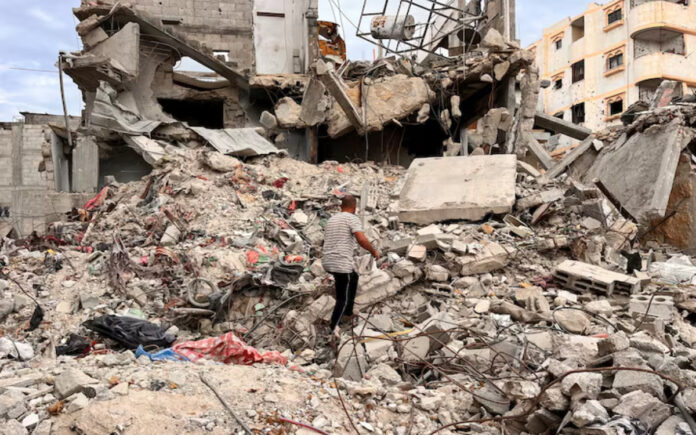Gaza: Moein Abu Odeh climbs atop a pile of rubble in southern Gaza, desperately searching for clothes, shoes, or anything he can sell to survive amid the relentless conflict. In the destroyed city of Khan Younis, he digs under debris and brushes away layers of concrete dust from the site of an airstrike, hoping to collect enough to afford flour for his family.
“If food and drink were available, believe me, I would give these clothes to charity,” said the father of four. “But the struggles we are going through mean we have to sell our clothes to eat and drink.”
Months of war and widespread shortages have fueled a desperate trade in salvaged clothing, often recovered from the ruins of homes belonging to victims of the conflict.
At one makeshift market, shoes, shirts, and sneakers are spread across dusty blankets. Children try on mismatched boots, hoping they can afford something warm for the winter.
Louay Abdel-Rahman, a displaced Palestinian, describes how the destroyed homes have become a grim source of livelihood. “We get clothing from a man whose house was destroyed. He digs through the concrete to retrieve them, and we buy them and sell them at a good price,” he said. Despite his efforts to earn, Abdel-Rahman also keeps some of the salvaged clothes for his own family. “The seasons have changed from summer to winter, and we need clothing,” he explained.
Also Read | Hezbollah and Lebanon Agree to U.S.-Mediated Ceasefire Amid Ongoing Tensions
Since Hamas’s October 7, 2023, attack and the subsequent military campaign by Israel, Gaza has been left in ruins. The devastation has generated an estimated 42 million tons of debris from destroyed homes, schools, mosques, and shops, according to the United Nations.
In April, the U.N. projected it would take 14 years to clear the wreckage, with cleanup costs exceeding $1.2 billion. More than 128,000 buildings have been destroyed or severely damaged, leaving families without shelter or essential supplies.
Also Read | Kremlin Responds to Biden’s Missile Strike Decision with Nuclear Doctrine Review
Saeed Doula, a father of seven, highlighted the dire situation: “All our children only have short-sleeve clothing, and nobody is helping them. The war is all-encompassing.”
The bleak circumstances have forced many Gazans to rely on salvaging and selling, underscoring the desperate conditions and the resilience of those determined to survive amid the chaos.



